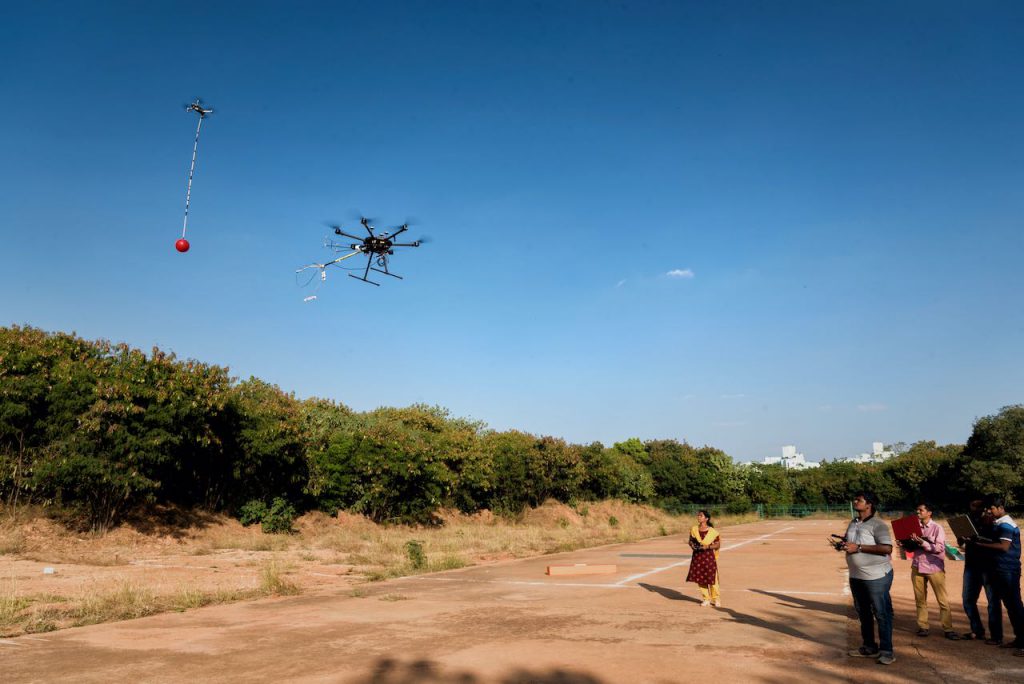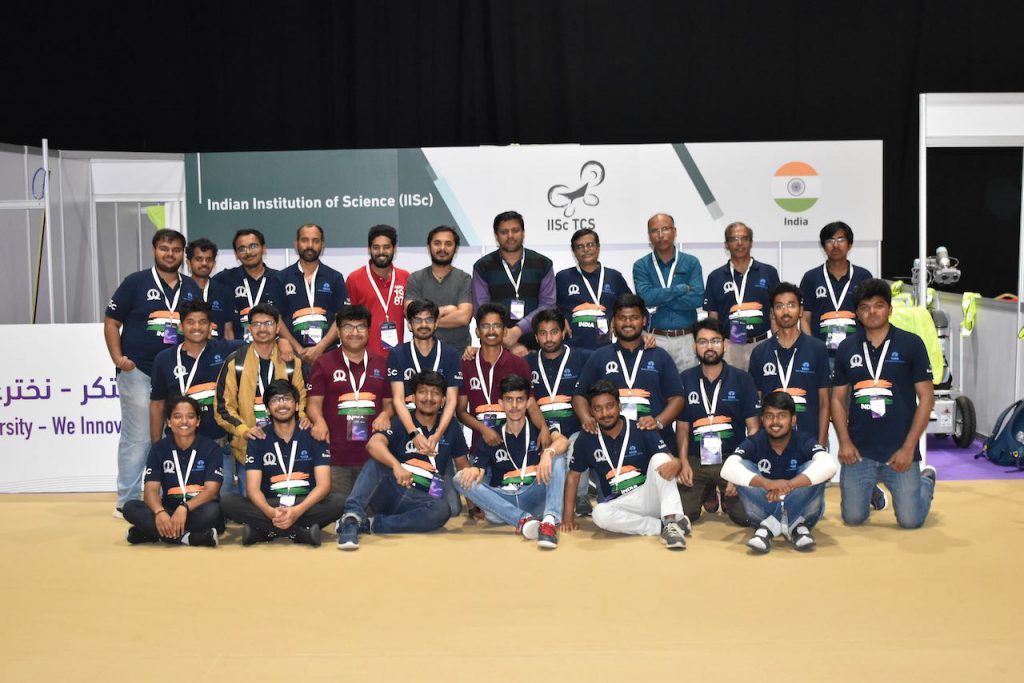IISc-TCS was the only Indian team to compete in the Mohamed Bin Zayed International Robotics Challenge 2020

The competition was only a few days away. With one drone having crashed already, all eyes were locked nervously on the two drones over the airfield outside the Department of Aerospace Engineering. During the final testing at the Department before leaving for the competition, one drone flew high with a red ball trailing beneath it, while another drone with a hoop and net followed it to try and catch the ball. But getting this right was only one of several challenges the team from IISc would have to get through at the competition. And once this final phase of testing was over, the team would have to pack up all their materials and instruments, ship them away, manage to get some sleep (which had so far proved elusive), and get on a flight to the United Arab Emirates to vie for prizes worth five million dollars. Two years of preparation would boil down to just minutes in the arena.
The Mohamed Bin Zayed International Robotics Challenge (MBZIRC), hosted by the Khalifa University of Science and Technology in Abu Dhabi, took place between 23 and 25 February 2020, followed by a symposium in which participants presented papers about their work in robotics. IISc was participating for the first time, in partnership with Tata Consultancy Services (TCS). In the first round of the competition, IISc-TCS was among 14 teams to receive sponsorship based on the proposal they submitted: they were awarded $100,000, disbursed in instalments (though this amount wasn’t sufficient to prepare for the competition – additional funds of Rs 86 lakh came from the Robert Bosch Centre for Cyber-Physical Systems at IISc, and Rs 40 lakh and equipment worth over Rs 1 crore came from TCS). Collaborations were allowed with industry, between universities, and even across countries.
IISc-TCS was among 14 teams to receive sponsorship based on the proposal they submitted: they were awarded $100,000
Though IIT Kanpur was also initially among the teams selected to participate this year, IISc-TCS was the only Indian team to make it to Abu Dhabi. Among the competitors were teams from universities like Virginia Tech, University of Bonn, Beijing Institute of Technology, Carnegie Mellon University, and Osaka University.
The Challenges
The teams could participate in three challenges: the first was based on unmanned aerial vehicle (UAV) safety and involved attempting to capture and neutralise intruder UAVs within a given area. To do this, teams would have to demonstrate that one of their UAVs could identify a moving target (in this case, a ball trailing from a drone), navigate towards it, capture it, and drop it off in a given location. The second challenge involved using UAVs as well as unmanned ground vehicles (UGVs) to build a structure by identifying large blocks by their colour, and picking, transporting and assembling them. The third challenge involved using three UAVs and a UGV for firefighting. The vehicles would have to autonomously sense and extinguish fires simulated in a building with multiple floors.
In addition, teams could take part in a Grand Challenge – a triathlon that involved taking on all three challenges simultaneously. The IISc-TCS team went in for the three individual challenges as well as the Grand Challenge, with IISc participants primarily focusing on the first two, and TCS primarily handling the firefighting challenge. The team’s best performances in the competition were in Challenge 2, in which they were ranked sixth out of 19 teams, and in the Grand Challenge, in which they were ranked ninth out of 17 teams. They also received a $1,000 cash voucher as a special recognition for the technical diversity involved in their solutions and for leading a large team.

A large team it certainly was: 60 people, with 40 from IISc, led by Principal Investigator Debasish Ghose – a professor at the Department of Aerospace Engineering – and 20 from TCS, co-ordinated by Kaushik Das – a scientist at TCS Innovation Labs. The team was divided into five groups working on different aspects of the challenges, and comprised PhD students, postdocs, project assistants and project associates from IISc, and scientists and researchers from TCS based in Bangalore and Kolkata. “We agreed to this partnership [with TCS] because they were willing to invest trained manpower and equipment to this large scale competition,” says Ghose. “Their expertise in building vehicles, which we need[ed] for the competition, was invaluable to us. The last, but certainly not the least, [important] factor that played a role in forging this excellent collaboration was that some of the top TCS scientists and engineers who were actively involved in this work were IISc alumni.”
The technical diversity they were lauded for was in Challenge 1, where they were ranked 13th out of 25 teams. “For Challenge 1, all other teams used the same type of manipulation mechanism to catch and pop the balloon [which was part of a secondary task],” says Lima Agnel Tony, Student Co-ordinator for the team and a PhD student at the Department of Aerospace Engineering. “We went with two approaches – one was the same forward-facing basket kind as the others, made by TCS researcher Rolif Lima, while the second one was a manipulator that extended sideways, made by IISc Project Assistant Vidyadhara BV. They both burnt the midnight oil in order to get them working. Our drone was within the volume specified by the organisers, unique in design, and effective.” An additional advantage of their sideways manipulator was that the same drone could be used to pop the balloon, instead of requiring a separate drone for it, as most other teams did.
Technical trouble
But the IISc-TCS team faced a major hurdle after reaching Abu Dhabi. Until that point, they had faced minor glitches in the form of delays in delivery from hardware suppliers, a mismatch between performance using software simulation and using actual hardware, and a crash during testing that meant having to borrow a drone from another department at the last minute. They had been able to overcome these to prepare for the challenges in Abu Dhabi, but one aspect threw them off balance after they arrived: “Because of the Telecom Regulatory Authority rules in India, several of the 20-plus channels in the 5.8 GHz frequency are not accessible by our devices, which could access only six or seven of them,” says Ghose. “This would not have been a hindrance but for the fact that the organisers had spread the 20-plus channels selectively over the large challenge arena, and so many channels that we could not access covered large parts of the arena.”
This created issues in deploying the autonomous codes, Tony points out, as the architecture they developed depended on inter-vehicle communication. They had to shift between manual mode and autonomous mode for some tasks, for which they lost points. In the second trial, they were unable to use their drone with the novel design for Challenge 1 and had to revert to the same method as the others. “I am pretty sure that we would have been placed way above other teams if communication worked the way we wanted,” says Tony – a sentiment that Ghose echoes.
“I am pretty sure that we would have been placed way above other teams if communication worked the way we wanted”
Despite the whirlwind of the last month, Ghose points out that even though IISc-TCS didn’t walk away with first place, they learned that their technology was no less innovative than that of other teams. He says, “In the second challenge we were supposed to identify, locate, pick up and place several long bricks, one over the other, autonomously. Our algorithms could do this so perfectly that the brick wall we built was perfect and looked like a wall that a mason has laid! On the other hand, none of the other teams could demonstrate this.” He credits the superior image processing and vision techniques that the team employed, integrated with the operation of a UGV-mounted manipulator arm, for their success.

“We developed many new technologies in designing grippers of various kinds, autonomous algorithms for multi-vehicle coordination which were implemented and shown to work, search algorithms, vision-based techniques, development and effective use of artificial intelligence and machine learning techniques, etc. Many of these are patentable and most will appear in journal and conference publications. In fact, in the symposium which followed the event, we had the maximum number of papers on new ideas,” says Ghose.
The experience of participating was an incredible opportunity, says Tony. “Every difficulty gave us an opportunity to learn and progress. Interactions with other teams and their mentors were meaningful. We met many acclaimed professors in our field. They were quite open and were ready to answer any of our queries.”
Though the last few days of testing in the airfield at IISc were certainly nerve-racking, Tony says that the time spent there was “beyond doubt” the most fun part of the preparations. “It was indeed a joy seeing the autonomous codes working flawlessly,” she says. “Irrespective of the end result, the two-year journey means so much to us as it moulded our team into one big family.”




